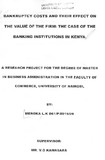| dc.contributor.author | Meroka, LK | |
| dc.date.accessioned | 2013-05-12T08:11:05Z | |
| dc.date.available | 2013-05-12T08:11:05Z | |
| dc.date.issued | 2003 | |
| dc.identifier.uri | http://erepository.uonbi.ac.ke:8080/xmlui/handle/123456789/22283 | |
| dc.description.abstract | The banking industry plays a major role in the economic development as they provide the
money to be invested, by matching the needs of depositors who have excess money in
their hands and the borrowers who have less money at their disposal. There is need to
understand the implications of banks being placed under statutory management.
The study'stwo objectives assessed the costs of bankruptcy as a percentage of the value
of the banks. The study sought to determine the relationship that exists between the costs
of bankruptcy and the value of the bank.
A sample of eight banks was drawn based on the data availed by the Central Bank of
Kenya for banks that failed between 1998 and 2002. The data of the operational banks
between 1996 and 2002 was used to develop the regression equation.
The findings were as follows:-
1. The costs of bankruptcy as a percentage of the value of the bank was significant for
the period of the study. The total costs of bankruptcy as a percentage of the total
assets of the bank was above a hundred percent in the year of failure. This implies
that bankruptcy costs are significant in the decline of the value of the bank when it is
placed under statutory management. There is need for stakeholders to determine the
probability of financiai distress and! or bankruptcy when making financing and
investment decisions to ensure the maximization of shareholders wealth.
II
2. The bankruptcy costs were noted to increase as the date of bankruptcy approached.
The bankruptcy costs may be reduced if the Central Bank of Kenya takes prompt
action to place all banks under statutory management when they begin to show signs
that the bank may experience financial distress. The bank may then reorganize its
operations and continue with the banking business.
3. The bankruptcy costs increased as failure approached for each of the three categories
as defined according to size. The bankruptcy costs were higher for the larger banks as
opposed to the smaller banks, as a percentage of the total assets. The mean of the
large banks is significantly different from that of the medium banks and the small
banks. This can be explained by the fact that the large banks have clientele who may
have ready access to public as well as private information on the banks performance
and they will act on the information promptly which makes the bankruptcy costs to be
high. The clientele of the small banks are likely to be small depositors who may not
have ready access to information on the banks performance and the large amounts of
cash required to open an account will shut them out of the large banks. This type of
depositors may react slowly to the information about the banks impending
bankruptcy. The medium banks will have depositors who are a cross between those of
the large and small banks.
On the basis of these findings, it is recommended that bankruptcy costs be considered
when making decisions as relates to financing and investment decisions, especially if the
bank is larger as the costs are higher. | en |
| dc.description.sponsorship | University of Nairobi | en |
| dc.language.iso | en | en |
| dc.subject | Bankruptcy costs and their effect on the value of the firm | en |
| dc.subject | Banking institutions in Kenya | en |
| dc.title | Bankruptcy costs and their effect on The value of the firm: the case of the Banking institutions in Kenya | en |
| dc.type | Thesis | en |
| local.publisher | School of Business | en |

